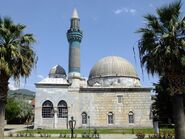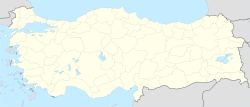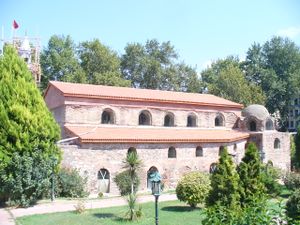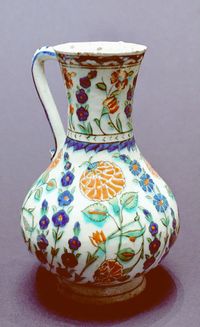إزنيق
إزنيق
İznik | |
|---|---|
مع عقارب الساعة من أعلى: General view of the town and بحيرة إزنيق، İznik Obelisk، المسجد الأخضر، خزف إزنيك من ع1560 و هاگيا صوفيا | |
 أقضية محافظة بورصة | |
| الإحداثيات: 40°25′45″N 29°43′16″E / 40.42917°N 29.72111°E | |
| البلد | تركيا |
| المحافظة | بورصة |
| الحكومة | |
| • العمدة | قدري إريلماظ (AKP) |
| • قائمقام | نور الدين كاكليأوغلو |
| المساحة | |
| • District | 736٫51 كم² (284٫37 ميل²) |
| التعداد (2022)[2] | |
| • الإجمالي | 44٬236 |
| • District | 43٬425 |
| • كثافة District | 59/km2 (150/sq mi) |
| Post code | 16860 |
| الموقع الإلكتروني | www.iznik.bel.tr |
إزنيق/إزنيك İznik، وكانت تاريخياً تُعرف بإسم نيقيا (Nicaea ؛ باليونانية: Νίκαια)، هي بلدة و قضاء إداري في محافظة بورصة، تركيا.[3] The town lies in a fertile basin at the eastern end of Lake İznik, bounded by ranges of hills to the north and south. مسافة الخط المستقيم بين إزنيق واسطنبول هي 90 كم جنوب شرق اسطنبول but by road it is 200 km (124 ميل) around the Gulf of Izmit. وتبعد 80 كم بالطريق عن بورصا.
İznik has been a district centre of the province of Bursa since 1930 but belonged to the district of Kocaeli between 1923 and 1927. It was a township of Yenişehir district (connected to Bilecik before 1926) between 1927 and 1930.
Ancient Nicaea was ringed with walls that survive to this day, despite having been pierced in places to accommodate roads. Inside the walls stands the Ayasofya Mosque where the Second Council of Nicaea was held in A.D. 787. The town is famous for the Iznik tiles and pottery.
أصل الاسم
İznik derives from the Ancient Greek name of the city, Νίκαια Nikaia (Latinized as Nicaea), prefixed with εἰς eis, meaning 'to' or 'into'. The Ottoman Turkish spelling is ازنيق: İznîq.[بحاجة لمصدر]
İznik appears as نيقية (Nîkıye) in Arabic sources, while Ibn Battuta, who visited the area, recorded it as يزنيك (Yiznîk).[4]
التاريخ
- للتاريخ قبل الفتح العثماني، انظر مقالة نيقيا.

في 1331، استولى على المدينة أورخان الأول from the Byzantines and for a short period the town became the capital of the expanding Ottoman emirate.[5] The large church of Hagia Sophia in the centre of the town was converted into a mosque and became known as the Orhan Mosque.[6] A madrasa and baths were built nearby.[7] In 1334 Orhan built a mosque and an عمارت (مائدة الرحمن) مباشرة خارج بوابة ينيشهر (Yenişeh Kapısı) في الجانب الجنوبي من البلدة.[8]
The Moroccan traveller Ibn Battuta stayed in Iznik at the end of 1331 soon after the capture of the town by Orhan.[9] According to Ibn Battuta, the town was in ruins and only inhabited by a small number of people in the service of the sultan. Within the city walls were gardens and cultivated plots with each house surrounded by an orchard. The town produced fruit, walnuts, chestnuts and large sweet grapes.[8][10]
A census in 1520 recorded 379 Muslim and 23 Christian households while another one taken a century later in 1624 recorded 351 Muslim and 10 Christian households. Assuming five members for each household, these figures suggest that the population was around 2,000. Estimates made in the 18th and 19th centuries arrived at similar numbers.[11] The town was poor and the population small even when ceramic production was at its peak during the second half of the 16th century.[12]
The Byzantine city is estimated to have had a population of 20,000–30,000 but in the Ottoman period the town was never prosperous and occupied only a small fraction of the walled area. It was, however, a centre for the production of highly decorated fritware vessels and what are known as İznik tiles during the 16th and 17th centuries.

In 1677 the English clergyman John Covel visited Iznik and found only a third of the town occupied.[13] In 1745 the English traveller Richard Pococke reported that Iznik was no more than a village.[14] A succession of visitors described the town in unflattering terms. For example in 1779, the Italian archaeologist Domenico Sestini wrote that Iznik was nothing but an abandoned town with no life, no noise and no movement.[8][15] In 1797 James Dallaway described Iznik as "a wretched village of long lanes and mud walls...".[8][16]
The town was seriously damaged by the Greek Army in 1921 during the Greco-Turkish War (1919–1922); the population became refugees and many historical buildings and mosques were damaged or destroyed. Between 26-28 November 1920, Greek army was defeated and İznik was completely freed on 28 November 1920. [17]
خزف وبلاط إزنيق
The town became a major center with the creation of a local faïence pottery-making industry during the Ottoman period in the 17th century (known as the İznik Çini, Çin meaning China). Iznik tiles were used to decorate many of the mosques in Istanbul designed by Mimar Sinan. However, this industry declined in the 18th century and İznik became a mainly agricultural minor town in the area when a major railway bypassed it in the 19th century. Currently the style of pottery referred to as the İznik Çini is to some extent produced locally, but mainly in كوتاهية, where the quality – which was in decline – has been restored to its former glory.
المعالم الرئيسية
A number of monuments were erected by the early Ottomans in the period between the conquest in 1331 and 1402 when the town was sacked by Timur. Among those that have survived are:
- İznik was originally ringed with 5 km (3 mi) of walls that were about 10 m (33 ft) high and enclosed within a double ditch on the landward sides. The walls incorporated over 100 towers. Large gates on the three landward sides of the walls provided the only entrances to the city. The western part of the walls rose up beside the lake which is sufficiently large that it cannot easily be blockaded from the land. Today the walls are ruined but enough still survives to provide a pleasant walking route.[18]
- Yeşil Mosque (Green Mosque), built for Çandarlı Kara Halil Hayreddin Pasha, the first Grand Vizier of the Ottoman Empire between 1378 and 1391. It is located near the Lefke Gate on the east side of the town. Damaged in 1922 during the Greco-Turkish War, it was restored between 1956 and 1969.[8][19]
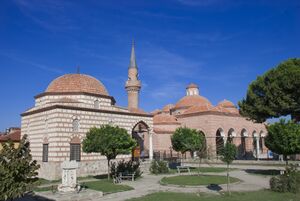

- Hagia Sophia, also known as Aya Sofya,[20] (Greek: Ἁγία Σοφία, "'Holy Wisdom') is a Byzantine-era former church which was built by Justinian I in the middle of the city in the 6th century.[21] It was here that the Second Council of Nicaea, a gathering of Christian bishops, was held in AD 787. After controversial rebuilding, it is now the Ayasofya Mosque (Turkish: Ayasofya Cami).[22]
- Hacı Özbek Mosque (1333). This mosque was built only three years after the Ottoman conquest. The portico on the west side of the building was demolished in 1940 to widen the road.[23]
- Basilica of Saint Neophytos, the ruins of a historical basilica thought to be the meeting place of the First Council of Nicaea, which has a very important place in Christian history.
- Nilüfer Hatun Soup Kitchen (Nilüfer Hatun Imareti) Built in 1388, the building was abandoned for many years but was restored in 1955 and is now a museum.[24]
- Süleyman Pasha Madrasa (mid-14th century). This is one of two surviving medreses in the town. It was restored in the 19th century and again in 1968.[25]
- Mausoleum of Çandarlı Hayreddin Pasha (14th century). The main chamber contains fifteen sarcophagi. A lower room contains three more sarcophagi including that of Ottoman-Tunisian statesman Hayreddin Pasha. It is located in a cemetery outside the Lefke gate to the east of the town.[26]
- Kilns Slight traces remain of the kilns used to make the pottery and tiles that once made İznik famous.
Several monuments survived into the 20th century but were destroyed during the Greco-Turkish War (1919–1922). These include:
- Church of the Koimesis/Dormition (6th–8th century but rebuilt after the 1065 earthquake). The only church in the town that was not transformed into a mosque,[27] it was decorated with 11th-century Byzantine mosaics which survive only in photographs.[28][29]
- Eşrefzâde Rumi Mosque (15th century). Eşrefzâde Rumi was married to the daughter of Hacı Bayram-ı Veli. He founded a sufi sect and after his death in 1469–70 his tomb became a pilgrimage site.[8] The mosque has been restored and the tomb is decorated with Iznik tiles.[30]
- Seyh Kutbeddin Mosque and Mausoleum (15th century). The mosque and mausoleum have been rebuilt.[31][32]
الأحياء
There are 46 neighbourhoods in İznik District:[33]
- Aydınlar
- Bayındır
- Beyler
- Boyalıca
- Çakırca
- Çamdibi
- Çamoluk
- Çampınar
- Çandarlı
- Çiçekli
- Derbent
- Dereköy
- Dırazali
- Elbeyli
- Elmalı
- Eşrefzade
- Göllüce
- Gürmüzlü
- Hacıosman
- Hisardere
- Hocaköy
- İhsaniye
- İnikli
- Karatekin
- Kaynarca
- Kırıntı
- Kutluca
- Mahmudiye
- Mahmut Çelebi
- Mecidiye
- Müşküle
- Mustafa Kemal Paşa
- Mustafalı
- Ömerli
- Orhaniye
- Osmaniye
- Sansarak
- Sarıağıl
- Selçuk
- Şerefiye
- Süleymaniye
- Tacir
- Yeni
- Yenişerefiye
- Yeşilcami
- Yürükler
الرياضة
The İznik Ultramarathon is a 130 km (81 mi) endurance running event that has taken place around Lake İznik every April since 2012. It is the country's longest single-stage athletics competition.[34]
العلاقات الدولية
البلدات التوأم – المدن الشقيقة
 Jingdezhen, China
Jingdezhen, China Khulo, Georgia
Khulo, Georgia Nikaia, Greece
Nikaia, Greece Pithiviers, France
Pithiviers, France Spandau (Berlin), Germany
Spandau (Berlin), Germany Talas, Kyrgyzstan
Talas, Kyrgyzstan Tutin, Serbia
Tutin, Serbia
الهامش
- ^ "Area of regions (including lakes), km²". Regional Statistics Database. Turkish Statistical Institute. 2002. Retrieved 2013-03-05.
- ^ خطأ استشهاد: وسم
<ref>غير صحيح؛ لا نص تم توفيره للمراجع المسماةtuik - ^ Lonely Planet Turkey ed. Verity Campbell 2007 Page 291 "Original İznik tiles are antiquities and cannot be exported from Turkey, but new tiles make great, if not particularly cheap, souvenirs."
- ^ Semavi Eyice (1988–2016). "İznik". TDV Encyclopedia of Islam (44+2 vols.) (in Turkish). Istanbul: Turkiye Diyanet Foundation, Centre for Islamic Studies.
{{cite encyclopedia}}: CS1 maint: unrecognized language (link) - ^ Raby 1989, p. 19–20.
- ^ Tsivikis, Nikolaos (23 March 2007), "Nicaea, Church of Hagia Sophia", Encyclopaedia of the Hellenic World, Asia Minor, Foundation of the Hellenic World, http://www.ehw.gr/l.aspx?id=8506, retrieved on 19 February 2012.
- ^ St. Sophia Museum, ArchNet, http://archnet.org/library/sites/one-site.jsp?site_id=3018, retrieved on 19 February 2012.
- ^ أ ب ت ث ج ح Raby 1989, p. 20.
- ^ Dunn 2005, p. 158 note 20. Raby (1989, p. 20) suggests a date between 1334 and 1339.
- ^ Defrémery & Sanguinetti 1854, pp. 323–324; Gibb 1962, p. 453
- ^ Raby 1989, pp. 20–21.
- ^ Raby 1989, p. 21.
- ^ Covel 1893, p. 281.
- ^ Pococke 1745, p. 123.
- ^ Sestini 1789, pp. 219–220.
- ^ Dallaway 1797, p. 169.
- ^ Uyan, Ayhan (28 November 2011), İznik'te Milli Mücadelede Yunan Tahribatı, iznikrehber.com, http://www.iznikrehber.com/yazarlar.php?kimlik=24-iznik%E2%80%99te+milli+mucadelede+yunan+tahribati-ayhan+uyan, retrieved on 19 June 2013
- ^ "Walls of Nicaea". The Byzantine Legacy (in الإنجليزية). Retrieved 2022-08-29.
- ^ Green Mosque, ArchNet, http://archnet.org/sites/2039, retrieved on 20 September 2014
- ^ "İznikte Gezilecek Yerler". Türkiye'nin En Güncel Gezi ve Seyahat Sitesi, GeziPedia.net (in التركية). Retrieved 2020-06-27.
- ^ Hazlitt, Classical Gazetteer, "Nicæa"[Usurped!]
- ^ "Ayasofya Orhan Camiisindeki restorasyon sorunları ufak tefekmiş! haberi". Arkeolojik Haber. 25 January 2019. Retrieved 2022-08-29.
- ^ Haci Özbek Mosque, ArchNet, http://archnet.org/sites/2034, retrieved on 20 September 2014
- ^ Nilüfer Hatun Soup Kitchen, ArchNet, http://archnet.org/sites/2803, retrieved on 20 September 2014
- ^ Süleyman Pasa Madrasa, ArchNet, http://archnet.org/sites/2800, retrieved on 20 September 2014
- ^ Tomb of Çandarli Hayreddin Pasa, ArchNet, http://archnet.org/sites/2802, retrieved on 20 September 2014
- ^ Kastrinakis, Nikos (16 June 2005), "Nicaea (Byzantium), Dormition Church", Encyclopaedia of the Hellenic World, Asia Minor, Foundation of the Hellenic World, http://asiaminor.ehw.gr/forms/fLemmaBodyExtended.aspx?lemmaID=8507, retrieved on 20 September 2014
- ^ Mango 1959.
- ^ Kanaki, Elena (22 June 2005), "Nicaea (Byzantium), Church of the Dormition, Mosaics", Encyclopaedia of the Hellenic World, Asia Minor, Foundation of the Hellenic World
- ^ Esrefzade Rumi Mosque, ArchNet, http://archnet.org/sites/2033, retrieved on 20 September 2014
- ^ Seyh Kutbeddin Mosque and Tomb, ArchNet, http://archnet.org/sites/2037, retrieved on 20 September 2014
- ^ "Şeyh Kutbettin Camii ve Türbesi / Osmanlı mimarisi".
- ^ Mahalle, Turkey Civil Administration Departments Inventory. Retrieved 12 July 2023.
- ^ "İznik'te maraton heyecanı başladı". Sabah (in Turkish). 2012-04-14. Retrieved 2013-11-26.
{{cite news}}: CS1 maint: unrecognized language (link) - ^ "Kardeş Şehirler". iznik.bel.tr (in التركية). İznik. Retrieved 2020-01-18.
المراجع
- Dallaway, James (1797), Constantinople Ancient and Modern: with excursions to the shores and islands of the archipelago and to the Troad, London: T. Cadell, junr. & W. Davies, http://books.google.co.uk/books?id=UahTO8bz3CAC.
- Defrémery, C.; Sanguinetti, B.R. trans. and eds. (1854) (in Arabic and French), Voyages d'Ibn Batoutah, Volume 2, Paris: Société Asiatic, http://books.google.co.uk/books?id=m-UHAAAAIAAJ.
- Dunn, Ross E. (2005), The Adventures of Ibn Battuta, University of California Press, ISBN 0-520-24385-4. First published in 1986, ISBN 0-520-05771-6.
- Mango, Cyril (1959), "The date of the narthex mosaics of the Church of the Dormition at Nicaea", Dumbarton Oaks Papers 13: 245–252.
- Raby, Julian (1989), "İznik, 'Une village au milieu des jardins'", in Petsopoulos, Yanni, Iznik: The Pottery of Ottoman Turkey, London: Alexandra Press, pp. 19–22, ISBN 978-1-85669-054-6.
- Sestini, Domenico (1789) (in French), Voyage dans la Grèce asiatique, à la péninsule de Cyzique, à Brusse et à Nicée: avec des détails sur l'histoire naturelle de ces contrées, London and Paris: Leroy, http://books.google.co.uk/books?id=YfsOAAAAQAAJ.
للاستزادة
- Alioğlu, E. Fusun (2001), "Similarities between early Ottoman architecture and local architecture or Byzantine architecture in Iznik", ICOMOS International Millenium Congress. More than two thousand years in the history of architecture, Session 2, Historic Towns, UNESCO-ICOMOS, http://www.unesco.org/archi2000/pdf/alioglu1.pdf.
- Alioğlu, E.Fusun (2001), "Establishing the sustainable identity of a historical city field of research: Iznik", ICOMOS International Millenium Congress. More than two thousand years in the history of architecture, Session 2, Historic Towns, UNESCO-ICOMOS, http://www.unesco.org/archi2000/pdf/alioglu2.pdf.
وصلات خارجية
- Iznik, ArchNet. Information on the historic buildings in the town.
- Photographs of the town taken in 2007 by Dick Osseman
- Pages using gadget WikiMiniAtlas
- CS1 التركية-language sources (tr)
- Short description is different from Wikidata
- Pages using multiple image with auto scaled images
- Coordinates on Wikidata
- Pages using infobox settlement with unknown parameters
- Articles containing Greek-language text
- Articles containing Ancient Greek (to 1453)-language text
- Articles containing التركية العثماثية (1500-1928)-language text
- Articles with unsourced statements from October 2024
- Articles containing explicitly cited عربية-language text
- Articles with hatnote templates targeting a nonexistent page
- مقاطعات محافظة بورصة
- منطقة مرمرة
- مدن تركيا
- بلدات ومدن رومانية في تركيا
- أماكن مأهولة في محافظة بورصة
- إزنيق
- أقضية محافظة بورصة
- Metropolitan district municipalities in Turkey
- Districts of Bursa Province
- World Heritage Tentative List for Turkey
- Cittaslow




